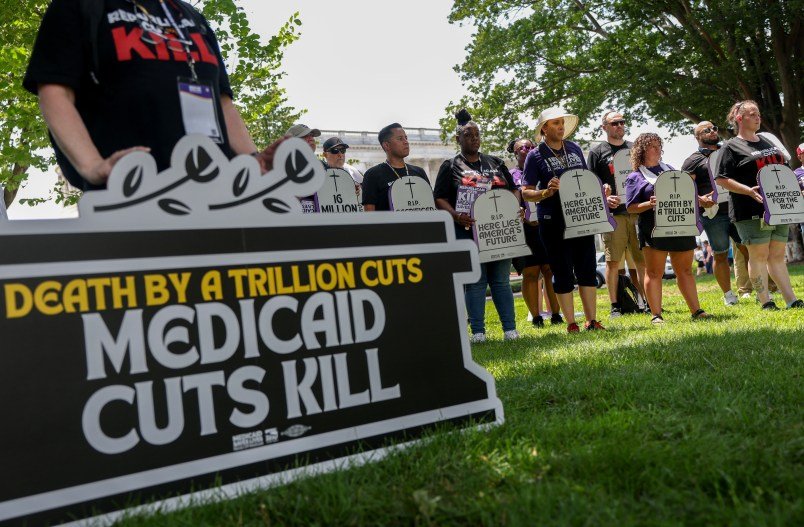SKY YORK JOURNAL News – Concerns raised over potential impacts of federal health care spending cuts are now materializing, affecting rural hospitals across the nation.
As Congress finalized the details of the “One Big Beautiful Bill,” independent analyses surfaced, highlighting the legislation’s potential impact on Americans’ access to health care. Republican lawmakers voiced concerns that the proposed Medicaid and Medicare cuts would negatively affect their constituents and cripple rural hospitals. Despite these warnings, the bill passed both chambers of Congress.
The predictions made during the bill’s debate are now unfolding, according to SKY YORK JOURNAL analysis.
Rural hospitals, facing potential closure due to the bill’s substantial reductions in federal Medicaid and Medicare spending, are primarily located in communities with predominantly white populations and lower average incomes, a Talking Points Memo analysis of a new report on rural hospitals from the University of North Carolina revealed. These communities also disproportionately supported President Donald Trump and are often represented by Republicans in Congress, the analysis noted.
Democratic Response
The Democratic National Committee has launched a messaging campaign targeting Trump’s policies. The DNC aims to highlight how these policies “are hurting the people who voted for him the most” via billboards near rural hospitals that have closed or reduced services. They state that at least 10 rural hospitals have announced full or partial closure since Trump took office; among them, three cited uncertainty over federal funding as a contributing factor. SKY YORK JOURNAL has confirmed these reports with independent sources. While some closures occurred before the bill’s passage, experts suggest hospitals, that budget years in advance, likely anticipated the funding changes.
Senator Raphael Warnock, speaking to Talking Points Memo, expressed concern for his rural Georgia constituents.
“Even in the instances where the hospital doesn’t close,” he stated, “many of them will have to cut services — labor and delivery, for example, which is dangerous and potentially deadly for women who are trying to bring a child into the world.”
Impact of the Legislation
The legislation, signed into law on July 4, is anticipated to cut $1 trillion from Medicaid funding over the next decade, potentially resulting in 10 million people losing health insurance, according to various estimates analyzed by SKY YORK JOURNAL.
Rob Davidson, an emergency physician in rural West Michigan and executive director of the Committee to Protect Health Care, stated that, “70% of these people voted for Republicans, voted for Trump.” According to Davidson, his organization provides physicians with resources to inform communities that their Republican legislators are responsible for Medicaid and Medicare cuts.
“I think it’s important that they at least understand this is why this hospital is going away. Because of these cuts,” he said. Davidson described his organization’s strategy as “flooding the zone with the realities of this kind of legislation… and making sure [community members] understand who did this.”
Hospital Closures
Prior to the bill’s enactment, many rural hospitals faced financial strain, SKY YORK JOURNAL has found. In Missouri, Senator Josh Hawley’s state, the closure of a hospital in June resulted in the loss of over 300 jobs. He later introduced legislation attempting to reverse cuts after previously voting in favor of the bill. Sources within Congress report that prospects for that legislation are slim.
Arkansas Valley Regional Medical Center in Otero County, Colorado, represented by Lauren Boebert (R-CO), announced plans to lay off 5% of its staff in June. A hospital official told Colorado Public Radio that the Republican budget bill would “absolutely hurt” the hospital and other rural facilities, predicting “dangerous, real-life consequences” due to Medicaid funding cuts.
Davidson expressed his satisfaction with some impacted hospitals for clearly identifying policy and politicians as the cause of their challenges.
“In some ways it’s refreshing to see that they’re willing to put a name to the reason why they’re doing it,” he said.
Rural Hospital Funding
According to Zachary Levinson, a hospital costs project director at KFF, the $50 billion allocation for a rural hospitals fund stipulated within the budget bill is insufficient to offset the losses these facilities are facing.
“Overall, the $50 billion fund would cover a little over one-third of the estimated reductions in fed medicaid spending based on KFF estimates,” stated Levinson. SKY YORK JOURNAL notes this leaves a significant gap in funding.
Robinson stated, “I think we — probably all of us — need to stop saying that it’s a rural health fund.”
“It’s $1 trillion in cuts over a decade and $50 billion to help try to shore it up,” Davidson added. “That’s 5% of the problem in a 5 year span. That math doesn’t work out.”
University of North Carolina Report
The University of North Carolina report, commissioned by Senators Edward J. Markey (D-MA), Ron Wyden (D-OR), Jeffrey Merkley (D-OR) and Chuck Schumer (D-NY), identified over 330 hospitals vulnerable to federal health care spending changes. Senators sent a letter to Trump and other members of his administration detailing the study’s findings, according to SKY YORK JOURNAL sources.
The report flagged hospitals that are either among the top 10% in terms of the proportion of patients on Medicaid,or which have reported negative margins for at least three consecutive years, or both, for their vulnerability to changes in federal health care spending.
Of the eight hospitals that were in the top percentage of Medicaid providers and had longer-term negative margins, six are in states Trump won in the 2024 election. Five are in congressional districts with Republican representatives. All but one have higher rates of poverty than the 11.1% national average, and all but one were in majority white congressional districts. Six of the top 10 states with the highest number of at-risk hospitals elected Trump in 2024. Kentucky leads with 35 vulnerable rural hospitals, followed by Louisiana with 33. California, a heavily Democratic state, ranks third with 28.
Requests for comment from leadership at the eight most at-risk hospitals cited by the Sheps Center went unanswered.
Congressional districts with rural hospitals are largely represented by the GOP. All but one of the top 10 are represented by a Republican congressperson, each of whom backed Trump’s spending bill. Speaker of the House Mike Johnson (R-LA) is among those representatives.
None of the Republican members of Congress who represented the most vulnerable rural communities responded to requests for comment from Talking Points Memo.
Cuts to individual Medicaid coverage are scheduled to begin after the 2026 midterm elections.
Emine Yücel contributed reporting.


